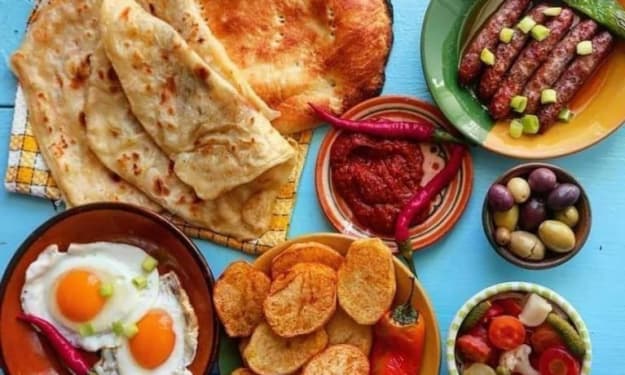Tunisian cuisine: hot but with taste
Discover the characteristics of Tunisian eating

After first visiting a restaurant, Europeans enjoying their first visit to the restaurant order a less smoking version. But they have no digestive problems. Tunisian cuisine will protect us in cold days.
Like any Arabic kitchen, Tunisian cuisine burns to our taste. You can find Mediterranean accents in it, especially French and Italian, but also Turkish. Many dishes have a similar color to red thanks to tomatoes and peppers. Tunisians believe that red activates appetite. Dishes are based on fish, seafood, lamb and poultry. They can't do without couscous, potatoes, eggs and bread.
Vegetables all year round
Tunisia has a regionally diverse kitchen - in the south it is more spicy, on the coast, often visited by Polish tourists, it is more mild. Restaurants don't really offer spicy dishes, but mush is always served so everyone can season the dish on their plate. Tunisian cuisine is rich in vegetables. Thanks to the appropriate climate, tomatoes, peppers, beans, artichokes, broccoli and various salads are harvested over and over again. No need to import any vegetables from abroad. Parsley (a source rich in vitamin C and iron) is recommended not as an appetizer over a ready-to-eat meal, but as an ingredient (e.g. in salads), as well as spinach and acid. Kale sheets are similarly used. It should also be noted that Tunisia is an important producer of excellent oil, unfortunately not available in Poland.
Spices and aromas hold a significant place in Tunisian cuisine, with paprika being the most important, followed by turmeric, garlic, and cumin. Lemon and parsley add flavor to the dishes. The Tunisian dish "harissa" is a paste made from hot peppers and garlic, and almost everything is seasoned with it. It is served as a light meal on a flat dish with olive oil and bread, which helps to moderate its spiciness. Tourists often buy jars of harissa as souvenirs, but locals prefer to make it at home. Tunisians say that their dishes can be divided into those eaten with a spoon (such as couscous and rice) and those eaten with a piece of bread. In Tunisia, an exceptionally large amount of bread is consumed. The French baguette is an essential addition to many dishes, torn apart here just as it is in France.
Brik - Fast Food #1
Brik plays the role of an underrated fast food here - it's a thin pastry made from a special dough (a type of pastry dough, which can ultimately be replaced with Greek phyllo pastry, not French) stuffed with filling. The most common are eggs, tuna, and mashed potatoes with tuna and shrimp. When making the crepe with eggs, be careful not to pour it while shaping the pastry. After baking, it remains semi-liquid, the trick is to eat brik without utensils so that the filling does not spill. There are also sweet bricks (like dried fruits). They don't have to be triangles, they can be cylindrical or pie-shaped. They are usually deep-fried, but sometimes baked in the oven - they have fewer calories. Stalls with brikami can be found on almost every street corner, but this Tunisian specialty (healthier than our fast food) can also be enjoyed in an elegant restaurant.
Couscous Tunisians consider this wheat semolina dish to be their national dish. In reality, fish couscous is a local specialty, while with chicken or lamb, various vegetables or dried fruits can be consumed in other Arab countries. For us, couscous is a quick preparation (just pour boiling water over it), but Tunisians first boil the wheat grains, then grind them into fine couscous, and then slowly steam it in a special pot.
Sweets for Sweet Tooths The best are seasonal fruits - fresh dates and ripe figs. It's hard to resist sweet biscuits filled with honey and dried fruits. They resemble Turkish baklava, but luckily, they are small in size and cannot be overeaten, especially as very sweet mint tea is served at the end of the meal.
Mint Tea This is the national drink of Tunisia. It is served in small cups (cup size), necessarily with a spoon. The bottom can be a roasted almond or pine nuts - eaten after drinking the tea. Although sweet mint may seem out of place after a hearty meal, it has been shown to greatly aid digestion.
Homemade Harissa The base of harissa is hot chili peppers. The dried peppers (about 5 oz) should be soaked in warm water for a short period. Then, rub 2-3 cloves of garlic with salt. The drained peppers are added, and everything is ground in a mortar or mixed, then sprinkled with a teaspoon of cumin, coriander seeds, and cumin. Finally, add a tablespoon of olive oil. Place the final sauce in a jar, pour a layer of olive oil on top. Store the harissa in the refrigerator. Use it as a seasoning for meat, vegetables, pasta, or rice dishes.
About the Creator
JENNA HERNANDEZ
I am an article writer who conducts research and writes well-structured, informative articles on a wide range of topics. My work involves gathering extensive information, organizing ideas logically, and ensuring clear, error-free language.






Comments
There are no comments for this story
Be the first to respond and start the conversation.